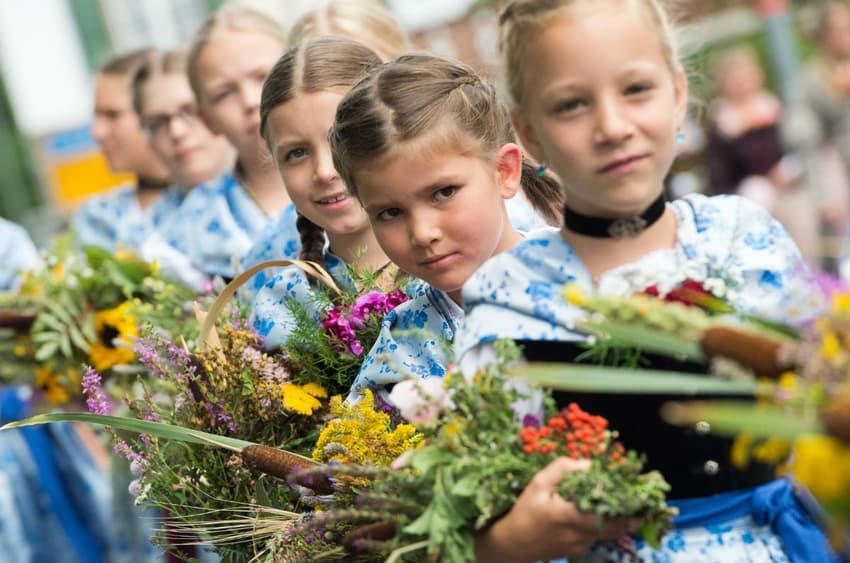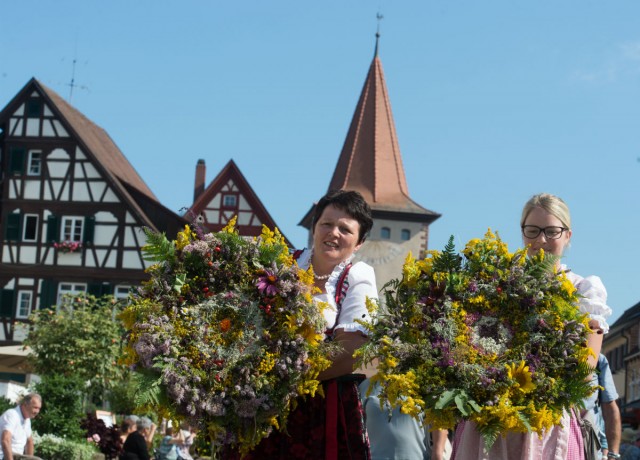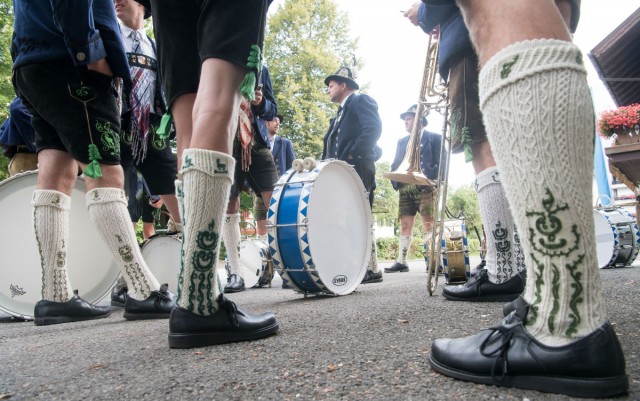Why Bavarians are busy hanging out bouquets on Mariä Himmelfahrt

You might not have the day off today, but many people across the country do. The Catholic celebration of Mariä Himmelfahrt is a lesser known yet rather floral public holiday in many parts of southern Germany.
What is Mariä Himmelfahrt?
Commonly celebrated on August 15th each year, Mariä Himmelfahrt is known in English as the Ascension of the Virgin Mary.
Catholics believe that heaven received the Virgin Mary’s body on this day, symbolizing human redemption. According to the Catholic faith, the Virgin Mary’s soul - as well as the souls of all human beings - lives on after her death.
Though introduced in the fifth century, the holiday has been celebrated since the seventh century. It has since come to be observed as a major feast day for Catholics.
Tuesday also marks the start of 30 Marian feast days, which are specific holy days recognized by Christians as significant for the celebration of events in the Virgin Mary’s life.
 Women in Baden-Württemberg. Photo: DPA.
Women in Baden-Württemberg. Photo: DPA.
Where is it celebrated?
Mariä Himmelfahrt is considered a public holiday in the state of Saarland and a large number of towns and cities in Bavaria - 1,704 out of Bavarian 2,056 municipalities, to be exact. These are municipalities where the majority of residents are Catholic.
If you live in Munich, Würzburg, or Augsburg, you probably kicked off your public holiday with a lie-in. But if you live in Nuremberg, you may have had to set you alarm clock this morning.
Five of the eight largest cities in Bavaria observe Mariä Himmelfahrt as a public holiday.
Some municipalities can actually lose or gain the public holiday depending on the area’s population of Catholics and whether this number increases or decreases. In 2014, for instance, as a result of the 2011 census, three Bavarian municipalities lost a public holiday whereas seven gained it.
But Germany isn’t the only country where the holiday is celebrated. It's also observed in all of Austria, parts of Switzerland and according to Dom Radio, the radio station of the Cologne Cathedral, certain areas in France, Italy, Luxembourg, Poland, Portugal, Spain, Belgium and Spain.
How is it celebrated?
More elaborately in particular places. In the Bavarian city of Kochel am See, an annual parade is held and a festival takes place where revellers are typically clad in traditional costumes.
 People in traditional clothing playing musical instruments in Kochel am See, Bavaria. Photo: DPA.
People in traditional clothing playing musical instruments in Kochel am See, Bavaria. Photo: DPA.
In rural areas, candle liturgies are a common sight.
But what seems to be most popular in the celebration of the custom are the abundance of herbal and flower arrangements where dozens of various herbs and plants are gathered, bunched together and blessed.
Some Catholics believe flowers and herbs were found in place of the Virgin Mary’s body at the opening of her tomb. This may explain why during the holiday bouquets of herbs are often hung up in front of homes, meant to protect against misfortune and illness.
Comments
See Also
What is Mariä Himmelfahrt?
Commonly celebrated on August 15th each year, Mariä Himmelfahrt is known in English as the Ascension of the Virgin Mary.
Catholics believe that heaven received the Virgin Mary’s body on this day, symbolizing human redemption. According to the Catholic faith, the Virgin Mary’s soul - as well as the souls of all human beings - lives on after her death.
Though introduced in the fifth century, the holiday has been celebrated since the seventh century. It has since come to be observed as a major feast day for Catholics.
Tuesday also marks the start of 30 Marian feast days, which are specific holy days recognized by Christians as significant for the celebration of events in the Virgin Mary’s life.
 Women in Baden-Württemberg. Photo: DPA.
Women in Baden-Württemberg. Photo: DPA.
Where is it celebrated?
Mariä Himmelfahrt is considered a public holiday in the state of Saarland and a large number of towns and cities in Bavaria - 1,704 out of Bavarian 2,056 municipalities, to be exact. These are municipalities where the majority of residents are Catholic.
If you live in Munich, Würzburg, or Augsburg, you probably kicked off your public holiday with a lie-in. But if you live in Nuremberg, you may have had to set you alarm clock this morning.
Five of the eight largest cities in Bavaria observe Mariä Himmelfahrt as a public holiday.
Some municipalities can actually lose or gain the public holiday depending on the area’s population of Catholics and whether this number increases or decreases. In 2014, for instance, as a result of the 2011 census, three Bavarian municipalities lost a public holiday whereas seven gained it.
But Germany isn’t the only country where the holiday is celebrated. It's also observed in all of Austria, parts of Switzerland and according to Dom Radio, the radio station of the Cologne Cathedral, certain areas in France, Italy, Luxembourg, Poland, Portugal, Spain, Belgium and Spain.
How is it celebrated?
More elaborately in particular places. In the Bavarian city of Kochel am See, an annual parade is held and a festival takes place where revellers are typically clad in traditional costumes.
 People in traditional clothing playing musical instruments in Kochel am See, Bavaria. Photo: DPA.
People in traditional clothing playing musical instruments in Kochel am See, Bavaria. Photo: DPA.
In rural areas, candle liturgies are a common sight.
But what seems to be most popular in the celebration of the custom are the abundance of herbal and flower arrangements where dozens of various herbs and plants are gathered, bunched together and blessed.
Some Catholics believe flowers and herbs were found in place of the Virgin Mary’s body at the opening of her tomb. This may explain why during the holiday bouquets of herbs are often hung up in front of homes, meant to protect against misfortune and illness.
Join the conversation in our comments section below. Share your own views and experience and if you have a question or suggestion for our journalists then email us at [email protected].
Please keep comments civil, constructive and on topic – and make sure to read our terms of use before getting involved.
Please log in here to leave a comment.